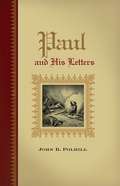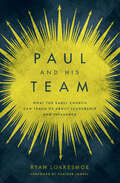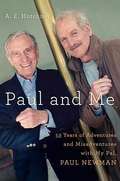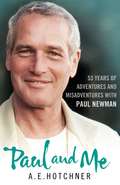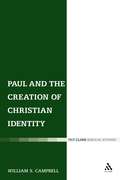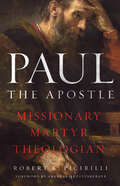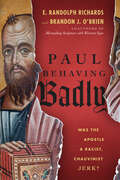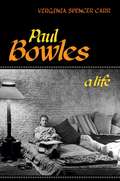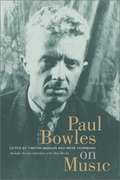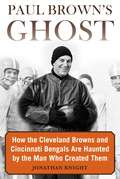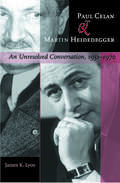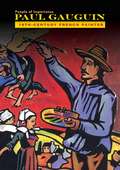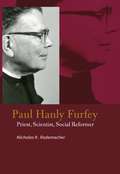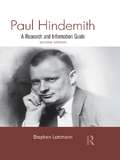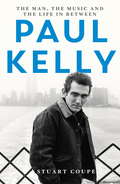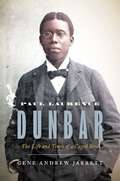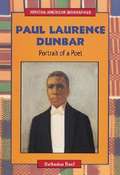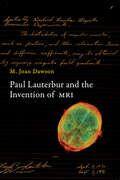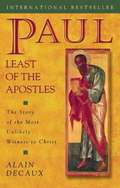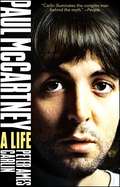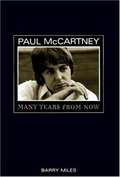- Table View
- List View
Paul and Ancient Rhetoric
by Porter, Stanley E. and Dyer, Bryan R. Stanley E. Porter Bryan R. DyerThe Apostle Paul lived and breathed in a Hellenistic culture that placed high value on the art of rhetoric, and recent advances in rhetorical criticism of the New Testament have resulted in a new emphasis on the rhetorical aspect of his letters. As many scholars have pointed out, however, it is not clear to what extent ancient rhetoric actually influenced Paul and his writing or how important rhetoric is for interpreting the Pauline corpus. This volume, containing contributions from major figures in the field, provides a nuanced examination of how ancient rhetoric should inform our understanding of Paul and his letters. The essays discuss Paul's historical context, present innovative advances in and trenchant critiques of rhetorical theory, and offer fresh readings of key Pauline texts. Outlining the strengths and weaknesses of a widely used approach, Paul and Ancient Rhetoric will be a valuable resource for New Testament and Classics scholars.
Paul and His Letters
by John Polhill<p>Except for Christ himself, no figure has been more influential in the history of Christianity than the apostle Paul. And yet his remarkable life remains shrouded in mystery. In this probing new book, John B. Polhill scrapes away the myths about this great man and uncovers the truth of his life and thought. <p>Using Acts, the Pauline epistles, and reliable traditions from non-canonical sources, Polhill weaves together the remarkable story of Paul's transformation from persecutor to persecuted, producing a dynamic account of his entire ministry. By placing each of Paul's letters in its proper historical context, Polhill brings new light to these foundation stones of the Christian faith. He follows Paul from his early years in Tarsus and Jerusalem to his imprisonment and eventual martyrdom, painting a detailed, comprehensive portrait of Paul that will serve as an indispensable resource for students, teachers, and pastors alike. </p>
Paul and His Team: What the Early Church Can Teach Us About Leadership and Influence
by Ryan LokkesmoeWhat can we learn about leadership and influence from Paul? Most Christians know something of the apostle Paul&’s life and ministry, but what about the incredible team of influencers he assembled and mobilized? Who were they, and how did Paul lead this team to accomplish God&’s purposes? Even more, what can we learn from their successes and failures, and how can we imitate their qualities? These are the questions that inspired Ryan Lokkesmoe, PhD, to write Paul and His Team. Like a church-ministry version of Team of Rivals, it reveals important principles about leadership and influence by showing how this early ministry team:Adapted to cultural, doctrinal, and interpersonal challengesFound common ground with their audiencesLed baby believers toward maturity Stayed united despite differing opinions Equipped others for the work of the ministryConducted their lives with self-discipline Built and maintained strategic partnerships Navigated sensitive cross-cultural situationsPersisted through difficulty, frustration, and fractured relationships Persevered when ministry was discouragingDeveloped leaders to replace themWhether you are in a position of leadership or are simply a passionate follower of Christ, you are an influencer that God is using to build His church. And while Paul and His Team certainly reveals a lot about Paul's character as a leader, it also highlights both prominent and obscure members of his team to offer a textured portrait of the early church&’s influence in spreading the gospel. Let&’s learn from the men and women God used to build the church, letting them shape our leadership and influence as we continue their work. Includes group discussion questions at the end of each chapter, making this book ideal for a church-staff or small group study.
Paul and His Team: What the Early Church Can Teach Us About Leadership and Influence
by Ryan LokkesmoeWhat can we learn about leadership and influence from Paul? Most Christians know something of the apostle Paul&’s life and ministry, but what about the incredible team of influencers he assembled and mobilized? Who were they, and how did Paul lead this team to accomplish God&’s purposes? Even more, what can we learn from their successes and failures, and how can we imitate their qualities? These are the questions that inspired Ryan Lokkesmoe, PhD, to write Paul and His Team. Like a church-ministry version of Team of Rivals, it reveals important principles about leadership and influence by showing how this early ministry team:Adapted to cultural, doctrinal, and interpersonal challengesFound common ground with their audiencesLed baby believers toward maturity Stayed united despite differing opinions Equipped others for the work of the ministryConducted their lives with self-discipline Built and maintained strategic partnerships Navigated sensitive cross-cultural situationsPersisted through difficulty, frustration, and fractured relationships Persevered when ministry was discouragingDeveloped leaders to replace themWhether you are in a position of leadership or are simply a passionate follower of Christ, you are an influencer that God is using to build His church. And while Paul and His Team certainly reveals a lot about Paul's character as a leader, it also highlights both prominent and obscure members of his team to offer a textured portrait of the early church&’s influence in spreading the gospel. Let&’s learn from the men and women God used to build the church, letting them shape our leadership and influence as we continue their work. Includes group discussion questions at the end of each chapter, making this book ideal for a church-staff or small group study.
Paul and Me: Fifty-three Years of Adventures and Misadventures with My Pal Paul Newman
by A. E. HotchnerBestselling author A. E. Hotchner's intimate account of his 53-year friendship with his pal Paul Newman. A. E. Hotchner first met Paul Newman in 1955 when the virtually unknown actor assumed the lead role in Hotchner's first television play, based on an Ernest Hemingway story. The project elevated both men from relative obscurity to recognition and began a close and trusted friendship that lasted until Newman's death in 2008. In Paul and Me, Hotchner depicts a complicated, unpredictable, fun-loving, talented man, and takes the reader along on their adventures. The pair traveled extensively, skippered a succession of bizarre boats, confounded the business world, scored triumphs on the stage, and sustained their friendship through good times and bad. Most notably, they started Newman's Own as a prank and watched it morph into a major enterprise that so far has donated all its $300 million in profit to charities including the Hole in the Wall Camps worldwide, dedicated to helping thousands of children with life-threatening illnesses. Paul and Me, complete with personal photographs, is the story of a freewheeling friendship and a tribute to the acclaimed actor who gave to the world as much as the world gave him.From the Hardcover edition.
Paul and Me
by A. E. HotchnerA. E. Hotchner first met Paul Newman in 1956, when the relatively unknown actor assumed the role James Dean was to play in Hotchner's first television play, based on an Ernest Hemingway story. The project elevated both men from relative obscurity to stardom, and commenced a close and trusted friendship that lasted until Newman's death in 2008. In A Friendship, Hotchner presents a complicated, unpredictable and talented man and leads the reader through their shared adventures. The pair travelled extensively around the globe, and owned fishing boats that involved them in embarrassing incidents. They successfully defended themselves before a jury in a ludicrous two-year trial, and triumphed in a beery tennis match against Robert Redford and Jack Valenti. Most notably, they started a food company, Newman's Own, as a prank and watched it soar into a major enterprise that has given all its 200 million dollars of profits to charities. Hotchner's knowledge of Newman is unparalleled, and as a gifted storyteller he brings to the reader crucial insights Newman revealed about himself. A Friendship is the story of an unusual friendship and a tribute to the beloved actor who gave to the world as much as the world gave him.
Paul and the Creation of Christian Identity
by William S. CampbellIn the dominant interpretation of the Antioch incident, Paul is viewed as separating from Peter and Jewish Christianity to lead his own independent mission. This book argues that diversity in Christ was fundamental to Paul and that particularly in his ethical guidance, this received recognition.
Paul The Apostle: Missionary, Martyr, Theologian
by Robert E. Picirilli&“Except for the Lord Himself,no single figure has done more for the Christian faith.&” If you want to understand Christianity, you need to understand Paul. But with so many books on the apostle, where do you start? Paul the Apostle is the ideal choice if you want a solid understanding of Paul&’s life, ministry, and writings without getting weighed down with minutia. Author Robert E. Picirilli, who taught college courses on Paul for over twenty-five years, found that most books on the apostle were either too technical or too basic, so he wrote a book that strikes a happy medium. It offers:A profile of Paul in his historical and cultural contextOutlines and explanations of his missionary journeys Introductions and brief analyses of each of his epistlesUseful for individual study or as a textbook (as it is in many universities today), Paul the Apostle is a great one-stop study of the man who wrote half the New Testament, spread the gospel to the heart of the known world, and gave his life for the Kingdom.
Paul The Apostle: Missionary, Martyr, Theologian
by Robert E. Picirilli&“Except for the Lord Himself,no single figure has done more for the Christian faith.&” If you want to understand Christianity, you need to understand Paul. But with so many books on the apostle, where do you start? Paul the Apostle is the ideal choice if you want a solid understanding of Paul&’s life, ministry, and writings without getting weighed down with minutia. Author Robert E. Picirilli, who taught college courses on Paul for over twenty-five years, found that most books on the apostle were either too technical or too basic, so he wrote a book that strikes a happy medium. It offers:A profile of Paul in his historical and cultural contextOutlines and explanations of his missionary journeys Introductions and brief analyses of each of his epistlesUseful for individual study or as a textbook (as it is in many universities today), Paul the Apostle is a great one-stop study of the man who wrote half the New Testament, spread the gospel to the heart of the known world, and gave his life for the Kingdom.
Paul Behaving Badly: Was the Apostle a Racist, Chauvinist Jerk?
by E. Randolph Richards Brandon J. O'BrienThe apostle Paul was kind of a jerk.
Paul Bowles: A Life
by Virginia Spencer CarrPaul Bowles, best known for his classic 1949 novel, The Sheltering Sky, is one of the most compelling yet elusive figures of twentieth-century American counterculture. In this definitive biography, Virginia Spencer Carr has captured Bowles in his many guises-gifted composer, expatriate novelist, and gay icon, to name only a few.
Paul Bowles on Music
by Paul Bowles Timothy Mangan Irene HerrmannThis volume collects the music criticism Bowles published between 1935 and 1946, with an interview conducted by Irene Herrmann shortly before his death.
Paul Brown's Ghost: How the Cleveland Browns and Cincinnati Bengals Are Haunted by the Man Who Created Them
by Jonathan KnightPaul Brown was a football genius and the father of two NFL franchises?the Cleveland Browns, who carry his name, and the Cincinnati Bengals. Arguably the most important figure in the history of the sport, he was a renowned coach and owner, and when he passed away on August 5, 1991, the game lost a giant. But for the Browns and Bengals, his death would herald a new era of bad luck, poor judgment, and comic folly that soon had fans whispering about a curse. Paul Brown’s Ghost explores the mystery surrounding the greatest ghost story in NFL history: why these two once-proud franchises have been perpetually denied good fortune in such dramatic, yet different ways—as if they’re being haunted by their mutual patriarch. Jonathan Knight takes readers through a haunted house filled with tales that explain the fraternal—almost biblical—connection between the teams. He examines the colorful characters and memorable moments that both defined and defiled the history of a rivalry that evolved from three decades of bad blood between Brown and Cleveland owner Art Modell. From coaches they shared to draft picks they both lusted after, the Browns and Bengals are connected in ways even their die-hard fans may not realize. Readers will discover the key role the Bengals played in the original Browns’ move to Baltimore, how the Browns were instrumental in the Bengals’ financially crippling new stadium deal, and how the Bengals actually almost became the new Browns. Through the lens of the enduring legacy of one of football’s pioneers, Paul Brown’s Ghost is a witty, whimsical look at decades of absurd incompetence set against the offbeat rivalry between football’s two most hard-luck teams.
Paul Celan and Martin Heidegger: An Unresolved Conversation, 1951–1970
by James K. LyonThis work explores the troubled relationship and unfinished intellectual dialogue between Paul Celan, regarded by many as the most important European poet after 1945, and Martin Heidegger, perhaps the most influential figure in twentieth-century philosophy. It centers on the persistent ambivalence Celan, a Holocaust survivor, felt toward a thinker who respected him and at times promoted his poetry. Celan, although strongly affected by Heidegger's writings, struggled to reconcile his admiration of Heidegger's ideas on literature with his revulsion at the thinker's Nazi past. That Celan and Heidegger communicated with each other over a number of years, and in a controversial encounter, met in 1967, is well known. The full duration, extent, and nature of their exchanges and their impact on Celan's poetics has been less understood, however. In the first systematic analysis of their relationship between 1951 and 1970, James K. Lyon describes how the poet and the philosopher read and responded to each other's work throughout the period. He offers new information about their interactions before, during, and after their famous 1967 meeting at Todtnauberg. He suggests that Celan, who changed his account of that meeting, may have contributed to misreadings of his poem "Todtnauberg." Finally, Lyon discusses their two last meetings after 1967 before the poet's death three years later. Drawing heavily on documentary material—including Celan's reading notes on more than two dozen works by Heidegger, the philosopher's written response to the poet's "Meridian" speech, and references to Heidegger in Celan's letters—Lyon presents a focused perspective on this critical aspect of the poet's intellectual development and provides important insights into his relationship with Heidegger, transforming previous conceptions of it.
Paul Elmer More (Twayne's United States Authors Series)
by Francis X. DugganCRITICISM has for some time been a distinctive category of American literature. Its dependence upon the primary genres and the related fact of its not being in itself a re-creation of primary experience will keep it from becoming what the novel became in nineteenth-century England and Russia or what the drama became in Elizabethan England; but criticism has been practiced in the United States in the twentieth century on an unprecedented scale. <P><P>Critics have heretofore usually been something else besides, and that something else has usually taken their major effort; one of the peculiarities of recent American literature is the sizeable body of writers for whom criticism has been a life's work. <P><P>Among the first of these, in achievement as well as in time, is Paul Elmer More. He is not, let me add immediately, so important a critic as others we might name; his criticism has not changed our conception of what literature is, as the criticism of Coleridge or of T. S. Eliot has. More is a critic of another sort; like Lewis Mumford or F. O. Matthiessen, he reads the literature of the past to see what it means to him and to his age, and in doing so discovers new meanings for us all.
Paul Gauguin: 19th-Century French Painter
by Diane CookFrench painter Paul Gauguin may not have been appreciated while he was alive, but his work later inspired many of the world's most famous artists, including Pablo Picasso. In the century since his death, Gauguin's work has become better known and more respected. He is famous for his use of color and unique style. Gauguin's work set him apart from other French painters of his time and helped to establish the style of Symbolism. Learn the story of one of the most influential artists of all time in Paul Gauguin: 18th-Century French Painter.
Paul Hanly Furfey: Priest, Scientist, Social Reformer
by Nicholas K. RademacherNicholas Rademacher’s book is meticulously researched and clearly written, shedding new light on Monsignor Paul Hanly Furfey’s life by drawing on Furfey’s copious published material and substantial archival deposit. Paul Hanly Furfey (1896–1992) is one of U.S. Catholicism’s greatest champions of peace and social justice. He and his colleagues at The Catholic University of America offered a revolutionary view of the university as a center for social transformation, not only in training students to be agents for social change but also in establishing structures which would empower and transform the communities that surrounded the university. In part a response to the Great Depression, their social settlement model drew on the latest social scientific research and technique while at the same time incorporating principles they learned from radical Catholics like Dorothy Day and Catherine de Hueck Doherty. Likewise, through his academic scholarship and popular writings, Furfey offered an alternative vision of the social order and identified concrete steps to achieve that vision. Indeed, Furfey remains a compelling exemplar for anyone who pursues truth, beauty, and justice, especially within the context of higher education and the academy. Leaving behind an important legacy for Catholic sociology, Furfey demonstrated how to balance liberal, radical, and revolutionary social thought and practice to elicit new approaches to social reform.
Paul Hindemith: A Research and Information Guide (Routledge Music Bibliographies)
by Stephen LuttmannPaul Hindemith: A Research and Information Guide is an annotated bibliography concerning both the nature of primary sources related to the composer and the scope and significance of the secondary sources which deal with him, his compositions, and his influence as a musician and teacher. The second edition includes research published since the publication of the first edition and provides electronic resources.
Paul Kelly: The man, the music and the life in between
by Stuart CoupeAustralia's best music writer examines the life of the Australian music legend - honest, revealing and a must-have for any Paul Kelly fan.Until now, no one has written the definitive biography of Australia's best-loved singer, song writer and poet. Taking us from Paul Kelly's family life as the sixth of eight children in Adelaide, Stuart Coupe, with Paul's blessing and access to friends, family and band mates, shows us the evolution from a young man who only really picked up a guitar in his late teens, to an Australian music icon. As Paul's music career took off he had to juggle the demands of rock'n'roll with real life and it wasn't always pretty. As Paul's manager for a time, Stuart Coupe has seen or heard it all - the good and the bad (like Paul being told by an audience member that his was the worst band ever!). The book will look at Paul Kelly's personal relationships and the impact they have had on Paul's career and his storytelling. It will also highlight his generosity to other artists, like Archie Roach. In 2017 Paul Kelly received an Order of Australia acknowledging his distinguished service to the performing arts and the promotion of the national identity through his contributions as singer, songwriter and musician. At the foundation of it all is his storytelling. PAUL KELLY: The man, the music and the life in between will give us an unfiltered examination of it all.
Paul Laurence Dunbar: The Life and Times of a Caged Bird
by Gene Andrew JarrettOn the 150th anniversary of his birth, a definitive new biography of a pivotal figure in American literary historyA major poet, Paul Laurence Dunbar (1872–1906) was one of the first African American writers to garner international recognition in the wake of emancipation. In this definitive biography, the first full-scale life of Dunbar in half a century, Gene Andrew Jarrett offers a revelatory account of a writer whose Gilded Age celebrity as the “poet laureate of his race” hid the private struggles of a man who, in the words of his famous poem, felt like a “caged bird” that sings.Jarrett tells the fascinating story of how Dunbar, born during Reconstruction to formerly enslaved parents, excelled against all odds to become an accomplished and versatile artist. A prolific and successful poet, novelist, essayist, playwright, and Broadway librettist, he was also a friend of such luminaries as Frederick Douglass and Orville and Wilbur Wright. But while audiences across the United States and Europe flocked to enjoy his literary readings, Dunbar privately bemoaned shouldering the burden of race and catering to minstrel stereotypes to earn fame and money. Inspired by his parents’ survival of slavery, but also agitated by a turbulent public marriage, beholden to influential benefactors, and helpless against his widely reported bouts of tuberculosis and alcoholism, he came to regard his racial notoriety as a curse as well as a blessing before dying at the age of only thirty-three.Beautifully written, meticulously researched, and generously illustrated, this biography presents the richest, most detailed, and most nuanced portrait yet of Dunbar and his work, transforming how we understand the astonishing life and times of a central figure in American literary history.
Paul Laurence Dunbar: Portrait of a Poet
by Catherine ReefA biography of the poet who faced racism and devoted himself to depicting the black experience in America.
Paul Lauterbur and the Invention of MRI
by M. Joan DawsonThe story behind the invention of the most important medical diagnostic tool since the X-ray.On September 2, 1971, the chemist Paul Lauterbur had an idea that would change the practice of medical research. Considering recent research findings about the use of nuclear magnetic resonance (NMR) signals to detect tumors in tissue samples, Lauterbur realized that the information from NMR signals could be recovered in the form of images—and thus obtained noninvasively from a living subject. It was an unexpected epiphany: he was eating a hamburger at the time. Lauterbur rushed out to buy a notebook in which to work out his idea; he completed his notes a few days later. He had discovered the basic method used in all MRI scanners around the world, and for this discovery he would share the Nobel Prize for Physiology or Medicine in 2003. This book, by Lauterbur's wife and scientific partner, M. Joan Dawson, is the story of Paul Lauterbur's discovery and the subsequent development of the most important medical diagnostic tool since the X-ray.With MRI, Lauterbur had discovered an entirely new principle of imaging. Dawson explains the science behind the discovery and describes Lauterbur's development of the idea, his steadfastness in the face of widespread skepticism and criticism, and related work by other scientists including Peter Mansfield (Lauterbur's Nobel co-recipient), and Raymond Damadian (who famously feuded with Lauterbur over credit for the ideas behind MRI). She offers not only the story of one man's passion for his work but also a case study of how science is actually done: a flash of insight followed by years of painstaking work.
Paul, Least of the Apostles: The Story of the Most Unlikely Witness to Christ
by Alain DecauxIn this compelling biography, Alain Decaux presents Paul as a man of exceptional passion and conviction, courage and faith, yet one branded by human contradictions, self-doubt, and personal weakness. Evoking memories of visits he has made to places where the Apostle lived and traveled, Decaux fuses the past with the present to offer and imaginative yet authentic vision of St. Pauls extraordinary story. Beautiful artwork images of the Apostle enrich the text, along with photos relating to Pauls travels.
Paul McCartney: A Life
by Peter Ames CarlinA biography of musician Paul McCartney, spanning from his years with The Beatles to his solo albums today.
Paul McCartney: Many Years From Now
by Barry MilesThis book is a history from the inside, of one of the greatest song-writing partnerships of the century. It is the private life of a man made public property - a Beatle - by the age of 21. It is the trajectory of the most popular pop group in history, from the beginnings to break-up.

